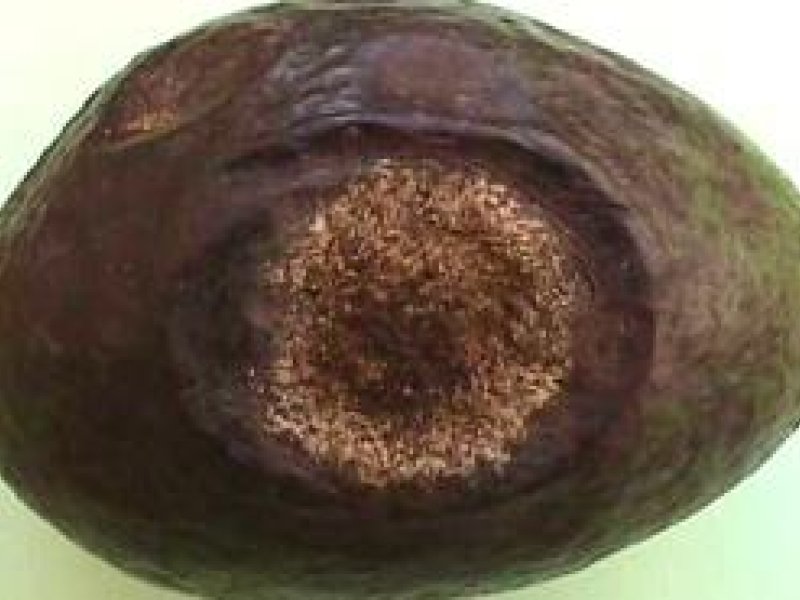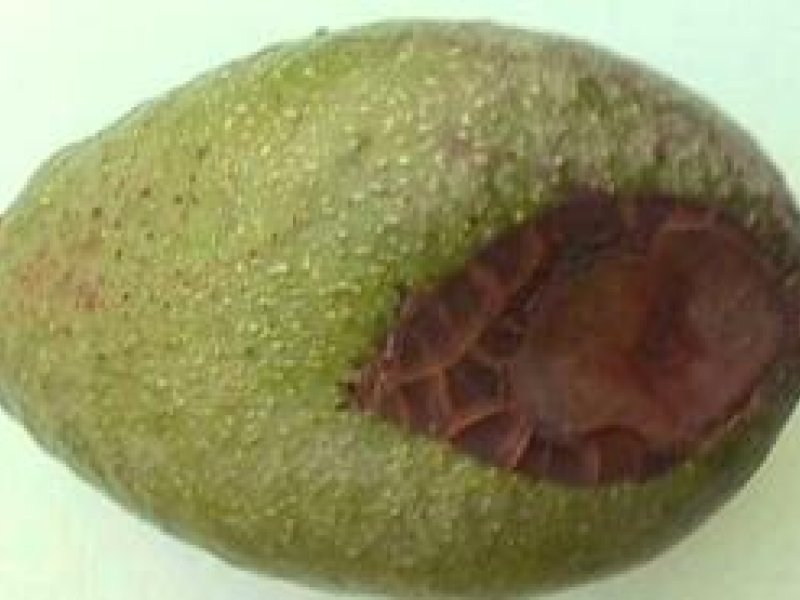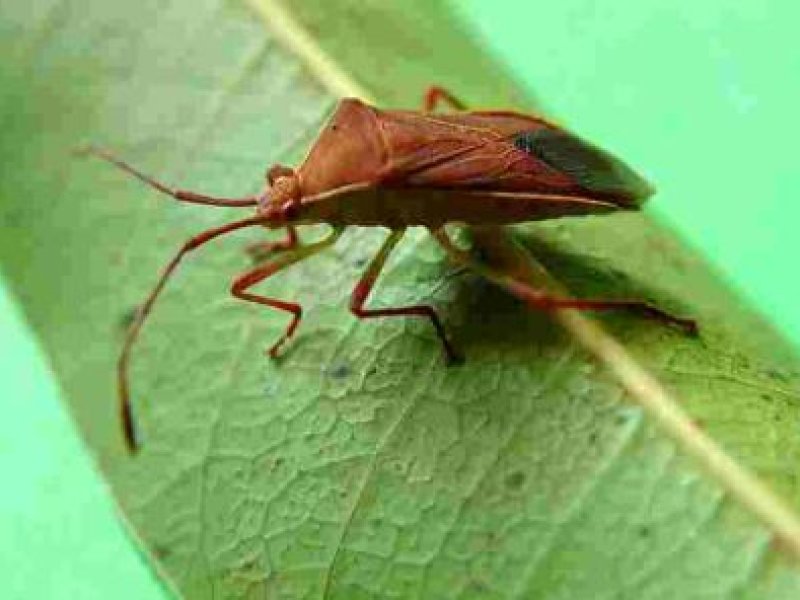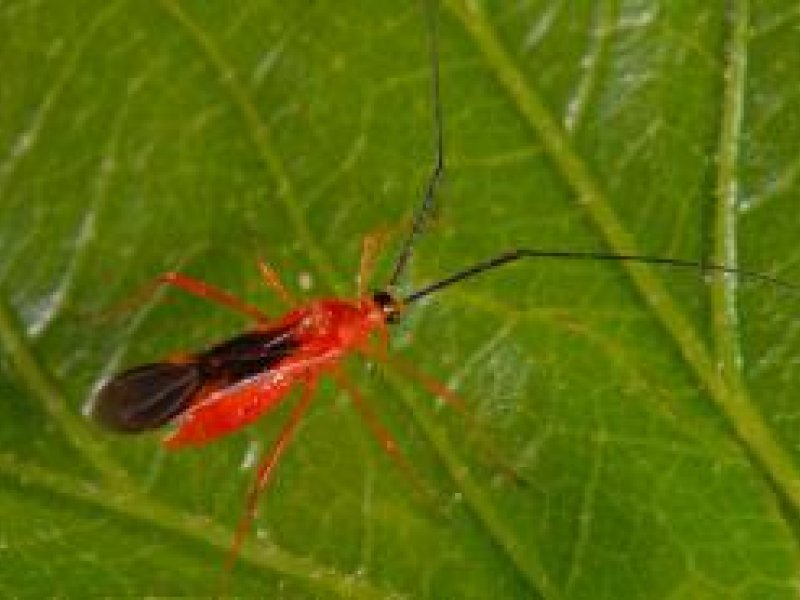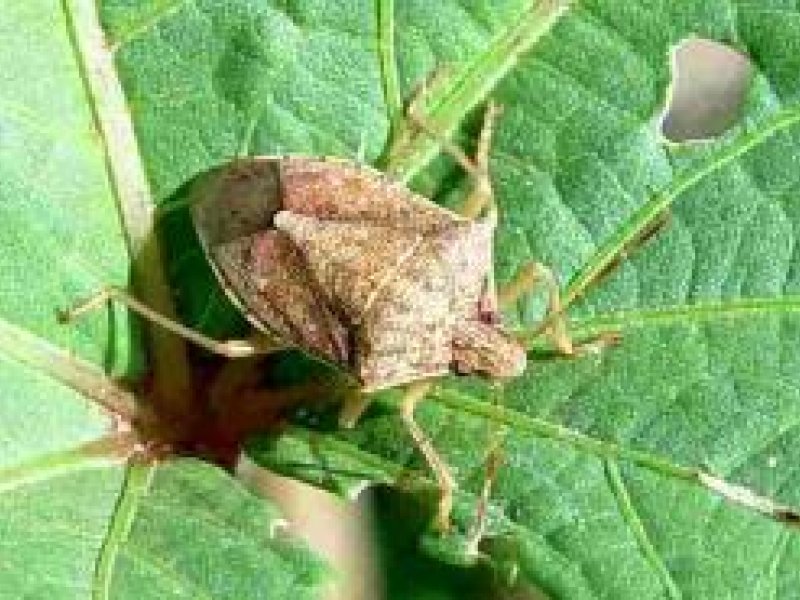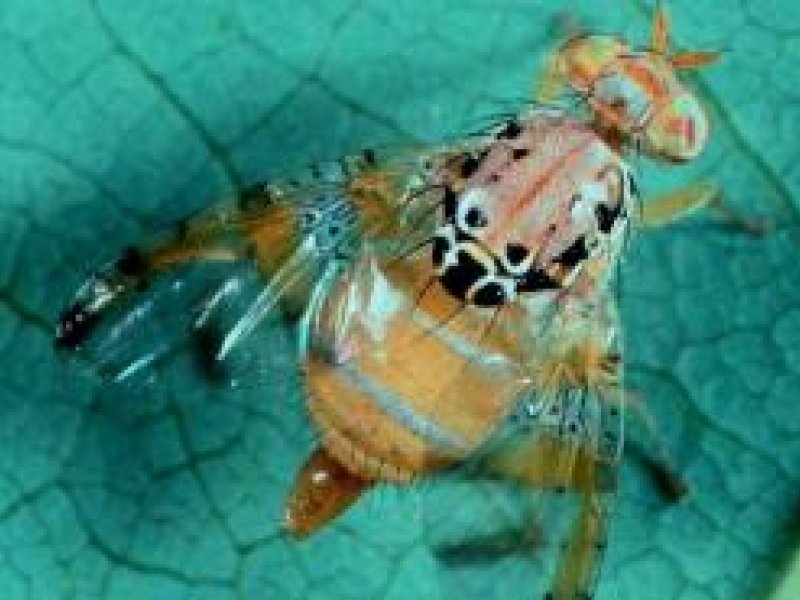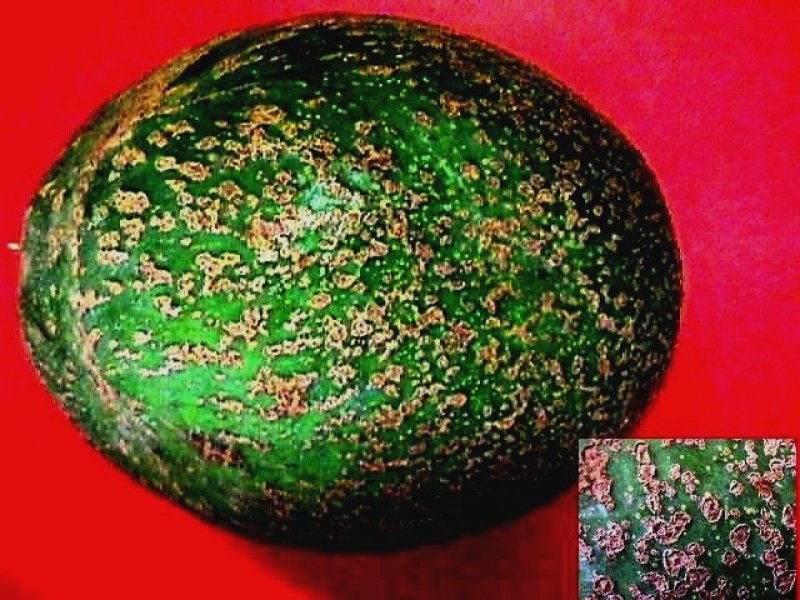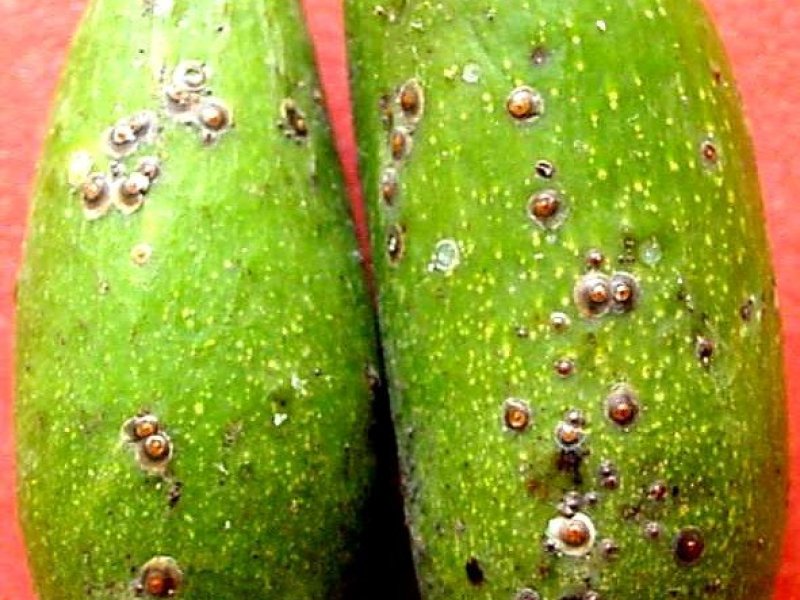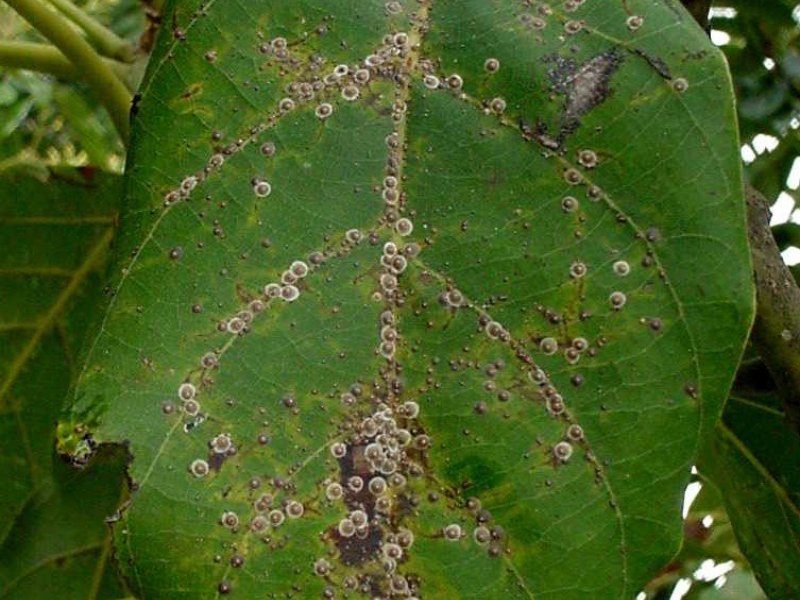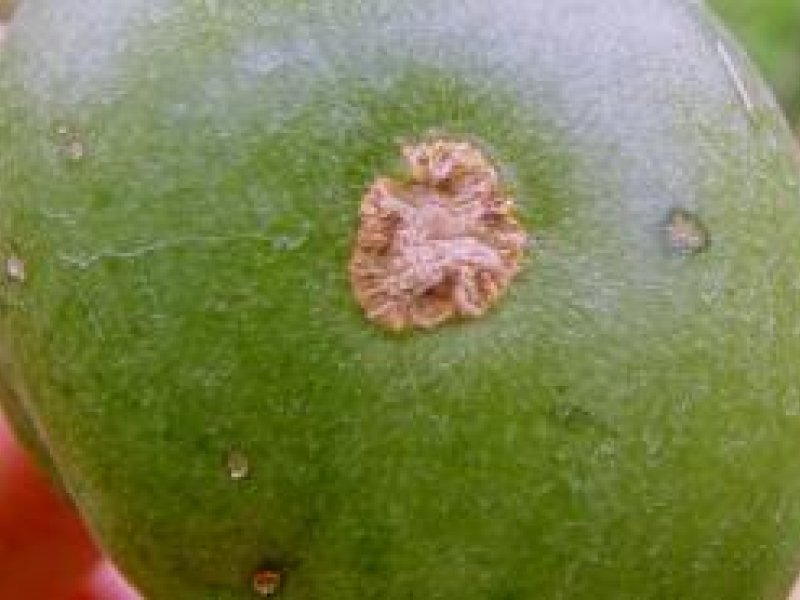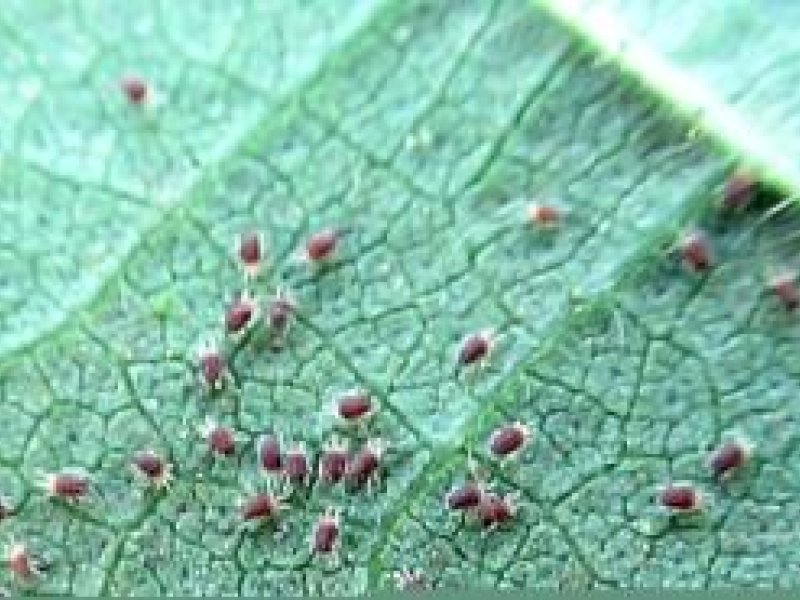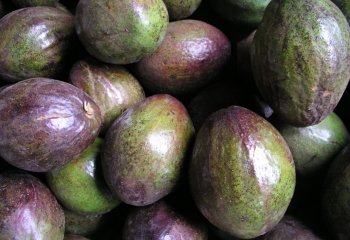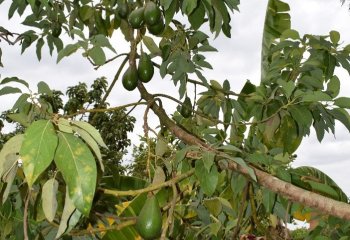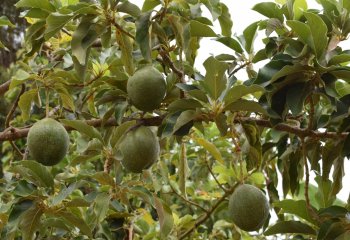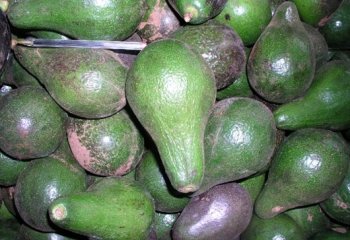|
Anthracnose (Colletotrichum gloeosporioides) This fungal disease is primarily a post-harvest problem when fruit is at maturity stage. Infection takes place when fruit is still very young and the fungus stays dormant till the fruit ripens. The disease appears as depressed spots on the fruit and the spots are manifested as a rot, which can penetrate deep into the flesh. In wet weather, the spots may be covered with mass of slimy, salmon pink fungal spore mass. The disease may develop very rapidly in storage if conditions in storage are humid and warm. The anthracnose fungus lives saprophytically on twigs, rotten fallen fruits and dead or dying infected leaves. The fungus is spread by water splash. |
|
|
What to do:
|
|
Avocado root rot (Phytophthora cinnamomi) This disease can attack trees of any size and age. Leaves of infected trees are small, usually pale or yellow green, are often wilted and fall prematurely giving the tree sparse appearance. In advanced stages of the disease, branches die-back and fruit remains small and crop yield drastically reduced. Feeder roots get blackened, decayed and died. Infected trees die prematurely. The disease is prone in areas subject to flooding and in poorly drained soils. The fungus can be spread or introduced to new areas by use of infected seeds, infested soil, irrigation water containing spores of the fungus and infected seedlings. The host range of the fungus includes Acacia, Camellia, Casuarina, Cypress, Eucalyptus and Grevillea. |
|
|
What to do:
|
|
Cercospora fruit spot (Pseudocercospora purpurea) The disease is primarily a problem to quality of fruits. The severity of infection varies from season to season and can cause losses of up to 60%. The lesions appear as small light-yellow spots on fruits and leaves. They later become reddish brown and eventually become hard and crack. Mature fruits are resistant. The disease development is favoured by humid conditions and high temperatures. The fungus is essentially spread by water splash and its spores are also wind-borne. |
|
|
What to do:
|
|
Bugs (Coconut bugs, Helopeltis bugs, stink bugs) Adult coconut bugs (Pseudotheraptus wayi) are brown in colour and 10 to 15 mm long. Nymphs are red brown to green brown in colour and have long antenna. The adults and nymphs of the coconut bug feed on young and mature avocado fruit. Bug feeding causes necrotic bruise-like depressions. A hard lump develops, which can be easily removed when the fruit is peeled. Helopeltis bugs also known as tea mosquito or mired bug are slender, delicate bugs, about 7- 10 mm long and have long legs and antenna. The females are red and the males are brown to yellowish red. The bugs prefer to feed on young plant tissue piercing the shoots, stems, leaves peduncles, petioles and fruits. Their feeding causes brown necrotic patches. Attacked leaves present angular lesion, which often drop out leaving holes as it attacked by biting insects. Feeding on young shoots causes dieback of the shoots. Feeding on fruits causes first a dark water-soaked mark around the feeding puncture, turning into a lesion with a light brown centre and black edge. The fruit may exude sap that forms a whitish deposit as it dries. Stink bugs are shield-shaped bugs variable in size (6 to 15 mm long) and colour (green to brown or reddish brown). They emit a characteristic unpleasant odour when disturbed. They usually feed on the developing fruit. The feeding punctures cause local necrosis resulting in fruit spotting, and deformation. |
|
|
What to do:
|
|
False codling moth (Cryptophlebia leucotreta) The false codling moth is small (wingspan of 16 - 20 mm), dark brown to grey in colour. The moths are active at night. Female moths lay single eggs mostly on the fruit. After emerging from the egg, the young caterpillar tunnels into the fruit and the fruit sap thus liberated forms a typical white crystalline excrescence on the surface of the fruit. When moths lay eggs on young fruits the caterpillars usually die and thus large caterpillars are seldom found. However, the caterpillars are able to develop if fruits are approaching maturity when infested. The young caterpillar is creamy-white with a dark brownish head. With age the body turns pinkish red. The fully-grown caterpillar is 15 to 20 mm in length. When mature the caterpillar leaves the fruit and pupates in the soil or beneath surface debris. |
|
|
What to do:
|
|
Fruit flies Avocados, especially thin-skinned varieties might be attacked by various species of fruit flies. Some fruit flies lay eggs under the skin of the fruit that is just beginning to ripen, but others attack young and old fruit. When the fruit reaches about the size of a golf ball a sting lesion appears as a slight puncture mark surrounded by a white exudate. As the fruit develops the lesion becomes dry and turn into distinct star-shaped crack on the skin surface. |
|
|
What to do:
|
|
Scab (Sphaceloma perseae) The fungus readily infects young, succulent tissues of leaves, twigs and fruits. Lesions appear as small dark spots, slightly raised, oval to elongated. These spots join up, giving a corky appearance to the surface of the fruits, impairing the appearance but not the internal quality of the fruit. Fruits are only susceptible when young until about half size development. The fungus requires moist conditions for sporulation and infection. |
|
|
What to do:
|
|
Scales Scales are small, stationary brown greenish insects occasionally found sucking sap from avocado leaves. Soft scales such as Coccus spp. excrete large amount of honeydew, which lead to the development of sooty mould on leaves, branches and fruit. Honeydew attracts ants, which while feeding on the honeydew protect scales from natural enemies. Armoured scales such as the coconut scale (Aspidiotus destructor) may encrust young twigs, leaves and fruit. They do not produce honeydew. Scales are usually not a problem in avocado orchards; however, damage can be serious on young tress and small twigs may be killed. Although the presence of scales on the skin of fruit does not cause internal damage, it may lead to rejection of fruit, especially if grown for export. |
|
|
What to do:
|
|
Spider mites (Oligonychus spp.) Attack by spider mites (Oligonychus spp.) produce circular necrotic spots covered by dense webbing. As mite populations increase feeding causes leaf drop. These mites are more damaging to 'Haas' variety; 'Fuerte' variety is less affected. Feeding by broad mites (Polyphagotarsonemus latus) causes leaf distortion. These tiny mites (0.1-0.2 mm long) cannot be seen with the naked eye, and are even difficult to detect with a hand lens. An attack by the broad mites can be detected by the symptoms of damage. Their feeding produces discolouration, necrosis and deformation of tissues. |
|
|
What to do:
|
|
Thrips (e.g. the black tea thrips Heliothrips haemorrhoidalis and the red banded thrips Selenothrips rubrocinctus) Thrips are small, slender insects (1-2 mm long) with two pairs of fringed wings. Adult thrips attacking avocado are dark brown or black, and the immature stages are yellow in colour. The red-banded thrips can be distinguished by a bright red band across the abdomen of immature thrips. Thrips are sometimes troublesome pests in avocado. They may cause damage to the leaves and fruit. Affected parts become whitish or silvery and are usually covered by dark-coloured droppings. On fruit, feeding begins near the calyx, gradually producing a scar that can cover the whole fruit. Attacked fruits develop a leathery brown skin. Feeding is most common on young fruit; economic damage generally occurs on fruit up to 2 cm in length (2-3 weeks after fruit set). Older fruit with thicker skin is less susceptible to attack. |
|
|
What to do:
|
Geographical Distribution in Africa
Geographical Distribution of Avocado in Africa. updated on 8th July 2019 (source FAOSTAT).
Avocado geographical distribution © OpenStreetMap contributors, © OpenMapTiles, GBIF. https://www.gbif.org/species/3034046
Read more
Gabon: Mvoku
Ghana: Pea, Paya
Guinea: Pya, Avocatier
Kenya: Ikolovia, Mukorobea, Parachichi, Avokado
Madagascar: Zavoka
Nigeria: Eben mbakara, Ube-Beke, Igba, Apoka, Ipia
Sierra Leone: Piya, Am-piya
South Africa: Avokado, Avokhado, Emakotapeni, Afukhada
Rwanda: Avoka
Tanzania: Mparachichi, Mpea
Togo: Paya
Uganda: Ova, Ovakedo
Zambia: Kotapela
Zimbabwe: Kotapeya (singular), Mukotapeya (Plural)
Local Names (Detailed)
Angola: Apakati (Umbundu); Abacate, Abacateiro, Caroco de abacate (Portuguese); Avocat (Français) (Bossard, et al., 1996): Mavoka, Mvoka (Kikongo) (Lautenschläger et al., 2018)
Benin: Avocatier (French) (Adjanohoun et al., 1986).
Burkina Faso: Avoka tiiya (Nadembega et al., 2011)
Burundi: Ivoka (Kirundi) (Ngezahayo et al., 2015)
Cameroon: Pia (Bamileke, Eton); Fia (Ewondo) (Tsabang et al., 2001); Avocatier (local French) (Mpondo et al., 2015).
DRC: Divoka, Savoka (Kongo) (Latham and Mbuta, 2006)
Ethiopia: Avocato (Sidamigna) (Tesemma et al., 1993).
Gabon: Mvoku (Tchouya et al., 2015)
Ghana: Pea, Paya (Twi dialect)
Guinea: Pya (Malinké, Kissi, Poular, Soussou); Avocatier (French) (Carrière, 1994).)
Kenya: Ikolovia (Kamba); Mukorobea, Maguna ngui (fruit) (Kikuyu); Makotulofia(Luhya); (Avokado (Luo); Mbokando(Fruit); Muvokando (Tree) (Tharaka, Meru), Parachichi (Swahili), (P Maundu and Bo Tengnas., 2005).
Madagascar: Zavoka (Malagasy) (Razafindraibe et al., 2013); Gavoka, Zavoka (betsimisaraka) (Sattler & Razafindravao, 2017).)
Nigeria: Eben mbakara (Ibibio) Ube-Beke (Igbo) (Aiyeloja & Bello, 2006); Ube bekee, Ube oyibo (Ibo), Igba, Apoka, Ipia (Yoruba), Eben mbakara (Ef), Piya (Hausa) (Ezuruike & Prieto, 2014).
Sierra Leone: Piya (Krio, Mende), Am-piya (Temne) (West Africa Cooks, n.d.).
General Information and Agronomic Aspects
Introduction
Avocado, is an evergreen tree that belongs to the Lauraceae (Laurel) family and genus Persea. Avocado is native to the tropical and subtropical regions of Central and South America but is now widely cultivated in many parts of the world, including most tropical countries of Africa. It is very nutritious with a high protein and oil content and is becoming increasingly important as an export crop.
The avocado oil is cholesterol free, of the monounsaturated type believed to protect against heart disease and certain kinds of cancers. The fruit is nearly sodium free, is rich in potassium dietary fibre and vitamin B6, C, D and E. It is eaten as fresh fruit, in salads, soups, ice cream, also used to make avocado oil, perfume and avocado paste. The family is characterized by the presence of aromatic essential oils and flowers with six tepals and six stamens, and fruits that are often fleshy and contain a single or several seeds.
It is best suited to warm climates with well-drained soils. In Africa, avocado is grown in various countries for both domestic consumption and export.
Avocado is widely cultivated for its fruit, which is consumed fresh or used in a variety of culinary applications, such as ice cream, salads, sandwiches, and smoothies. The fruit is a good source of healthy fats, dietary fiber, vitamin B6, C, D and E, and minerals, and has been associated with various health benefits, such as improved heart health, weight management, and digestion. In addition to its use as food, avocado has also been traditionally used in various medicinal applications. The pulp and seed of the fruit contain compounds that have been shown to have anti-inflammatory, antimicrobial, and antioxidant properties, and may have potential therapeutic applications for conditions such as arthritis, diabetes, and cardiovascular disease. The leaves are used for medicinal purposes. Avocado oil, extracted from the fruit is cholesterol free, of the monounsaturated type believed to protect against heart disease and certain kinds of cancers. The oil is also used in cosmetics, as it is rich in vitamins, minerals, and fatty acids that are beneficial for the skin and hair health (Yahia, E. M., & Woolf, A. B, 2011, Orwa et al, 2009, GBIF, 2021).
|
Ⓒ P Maundu, 2021 |
Ⓒ Adeka et al., 2001 |
Species account
Avocado is a medium to large evergreen tree that typically grows to a height of between 9-20. While the tree is categorized as an evergreen, some varieties may shed their leaves briefly prior to flowering. The tree canopy can vary from low and dense to upright and asymmetrical. Leaves: shape vary from elliptic to oval or lanceolate, with a typical length of 7-41 cm. These leaves are usually covered with fine hairs and display a reddish hue when young, but as they mature, they become smooth, leathery, and take on a dark green color. Flowers: yellowish-green and measure approximately 1-1.3 cm in diameter. Fruit: a large, pear-shaped berry that has a thick, rough, dark green or blackish skin and a soft, creamy, pale green or yellowish pulp. The skin of the fruit varies in thickness and texture, and the fruit itself can be green, black, purple, or reddish in color when mature, depending on the variety. Avocado fruits can range in shape from spherical to pear shaped and can weigh up to 2.3 kg (Orwa et al, 2009, GBIF, 2021).
|
Ⓒ P Maundu, 2021 |
Ⓒ P Maundu, 2021 |
Avocado varieties.
Avocados exhibit significant variation in size, shape, color, texture, flavor, and nutritional content. There are hundreds of different avocado varieties, which can be categorized into three main groups: West Indian, Guatemalan, and Mexican.
West Indian avocados are the largest and have a smooth, shiny skin and a slightly sweet taste. They are typically consumed raw and are primarily cultivated in tropical areas like the Caribbean. Guatemalan avocados are medium-sized with a thick, bumpy skin and a buttery, nutty flavour. They are the hardiest group and can withstand colder temperatures and higher altitudes, making them popular for commercial farming. Mexican avocados are the smallest and have a dark, wrinkled skin and a creamy texture, making them a preferred ingredient in traditional dishes like guacamole.
In addition to these three groups, there are also many hybrid varieties of avocados that have been developed through cross-breeding. Hybridization is a common cause of variation in avocados and other fruits, as it allows for the mixing of desirable traits from different parent plants. For instance, the popular Hass avocado is a hybrid of Guatemalan and Mexican avocados, with a thick, pebbly skin, a rich, creamy texture, and a nutty, buttery flavour. Other popular hybrid varieties like the Reed and Lamb Hass also exist. Farmers typically choose avocado varieties based on various factors, such as fruit size, yield potential, taste, texture, disease resistance, and market demand. These criteria play an essential role in determining the profitability of avocado farming (Wikifarmer, n.d).
Ⓒ Maundu, 2021
Common Kenyan avocado varieties
Fuerte
Hybrid of Guatemalan and Mexican races with thin skinned green-pebbled fruit of very good flavour. Fuerte is one of the major varieties in export markets
The tree is broad, very productive but susceptible to both Anthracnose and Scab.
This variety has many lines with different shapes; the pear shaped fruit is smooth, medium-thin skin that peels easily, with dense, pale green flesh with a good flavour preferred in the export market. Matures 6-8 months after flowering
Pear-shaped smooth, medium-thin skin that peels easily, with dense, pale green flesh with a good flavor.
Skin remains green when fruits are mature
Creamy, pale green flesh
Matures 6-8 months after flowering
ⒸPatrick Maundu 2021
Hass
- Vigorous grower and bears medium-sized, rounded, rough-skinned, black fruits. Propagates well. Matures 8-9 months after flowering.
- The tree grows tall and requires cutting back
- Distinctive for its tumbled leathery fairly thick skin that turns near black when fully ripe.
- he flesh closest to the skin is a lush pale lime green color and as it nears the central pit it develops a rich creamy yellow tone and softer, oil rich texture
- Oval-shaped fruit with small to medium seed
- Flavor creamy and smooth with a nutty and sweet finish
- Outstanding shelf-life and shipping characteristics
- One of the longest harvesting seasons.
‘Puebla’
- Spreading, dark green tree bearing deep purple to maroon round fruit. This variety is normally used as a rootstock. Matures 5-7 months after blossoming.
- Small compact fruits resembling “Hass”
- Fruit is deep maroon and smooth
- Fruit has a velvety flesh with nutty aroma and
- a rich butter tastes
- This variety is normally used as a rootstock
‘Pinkerton’
- Long, pear-shaped fruit with small seed
- Large fruit that weighs 225 – 510 g per fruit
- Medium thick green skin with slight pebbling
- Green skin deepens in color as it ripens
- Excellent peeling
- Creamy, pale green flesh
Nabal
Bears fruit in alternate years. Its green fruits have a good flavour. Matures 8-9 months after flowering.
Others: 'Reed', 'Simmonds', 'Booth 7&8', 'Pinkerton', 'Bacon', 'Lula' and 'Taylor'. These are grown but not exported ( Mugambi 2002)
Varieties in Uganda include:
Hass avocado is the most commonly grown and can be found in different parts of the country.
Varieties in Tanzania:
The Hass and Fuerte are the primary commercial avocado varieties cultivated for export, although they are also available in limited quantities in the domestic market. Conversely, local avocado cultivars, while popular in domestic markets, have a shorter shelf life when ripe and are therefore not commonly exported. Other varieties grown in Tanzania include Booth 7, Puebla, Pinkerton, Uyole line, X-ikulu, Simmonds, Ettinger, Zutano, Weisal and Nabal
Ecological information
Depending on variety, avocado grows well from 0-2100 m above sea level (asl). The varieties 'Tonnage', 'Simmonds', 'Booth 7&8' are suited to lowland areas between 90 and 800 m asl. 'Hass' and 'Nabal' are suited to altitudes 800-2100 m asl. 'Fuerte' and 'Puebla' are suited to altitudes 1500-2100 m asl.
Avocado grows successfully on many types of soil provided they are deep, with good water holding capacity and free draining. Water logged or saline soils are unsuitable because avocado plants are sensitive to excessive soil moisture and high salinity. The optimum pH is 5.5-6.5. Temperatures between 16 and 24degC are good for growing avocados. Maximum temperature for avocado is 33degC. Above this temperature avocado fruits and trees can be damaged. High temperatures and direct sunshine can cause sunburn damage to exposed fruit. Avocado will not grow where frost can occur. An annual rainfall 1200 mm is optimal for good production. Water requirements are not less than 1000 mm/year. If supplementary water is required not more than 50 mm at a time may be applied. Climatic conditions with alternating dry and rainy seasons are best for avocados.
Agronomic aspects
Propagation and planting
Select healthy seeds and plant them in boxes or seedbeds. Immediately after germination transplant the seedlings into 4 litre pots, tins or polythene bags. Water them regularly until they are pencil thick. Grafting should be carried out when the seedling reaches pencil thickness. Wedge grafting method is most successful. Grafting should be done at the point where rootstock is soft. The scion should be dormant at the time of grafting and should match the size of the stock. Wrap the grafting point thoroughly to exclude water from the union and to prevent it from drying out.
Land preparation
The fields should be cleaned by removing tree stumps, bushes and perennial weeds. Then the land should be mowed or cultivated.
Planting out
Generally a spacing for pure stands of avocadoes of 9m x9m will be suitable. Dig holes of 60cmx60cm by 60cm deep keeping the top soil and the sub soil separate. Mix the top soil with 1 bucket (20 litre) of well rotted manure or compost and 1-2 handfuls of Mijingu rock phosphate. Remove the plant from its pot keeping the root and soil structure intact (easiest if it has been properly wetted ahead of time) and plant out using only the topsoil mixture to fill the hole.
The subsoil may be used to make a basin around the tree. Water the seedlings immediately after planting if it is not in the rainy season. Shade the young plants with banana leaves or similar material after planting and when they are putting up a new flush. If planted in a windy area, a windbreak will be necessary to protect the plants from leaning to one side and to help prevent leaf shedding fruit drop and bruising.
Manuring
One avocado tree can yield 250-300 kg of fruit per harvest season. This causes a high demand on soil nutrients. To determine the right amount of manure to apply the soil should be tested annually, otherwise the following table can be used as a guide for organic farmers for manuring individual trees:
|
Age of tree (years) |
Nitrogen and potassium |
Mijingu rock phosphate |
Additional potassium Ashes (handfuls) |
Manure or compost decomposed |
|
1-3 |
8 |
500 g |
- |
15 Kg |
|
4-5 |
16 |
900 g |
- |
15 Kg |
|
6-7 |
30 |
1.4 Kg |
1 |
30 Kg |
|
8-9 |
46 |
1.4 Kg |
2 |
30 Kg |
|
10-14 |
60 (three 20 litre buckets/year, mixed with 12 buckets of water, divided into several applications) |
2 Kg |
4 |
30 Kg |
|
15+ |
80 (four 20 litre buckets/year mixed with 16 buckets of water, divided into several applications |
2.5 Kg |
8 |
30 Kg |
Adapted from AIC advice for conventional farmers replacing conventional fertilizers with natural products to get the same amount of nutrients.
If chicken manure is available, it can be used instead of animal urine as follows, but spread on top of the soil far enough from the tree stem to avoid burning the stem:
|
Age of tree (years) |
Chicken manure Kg/tree/year |
Additional Mijingu Rock phosphate |
Additional potassium Ashes - (handfuls) |
Compost decomposed |
|
1-3 |
1.5 |
150 g |
- |
15 Kg |
|
4-5 |
3 |
300 g |
- |
15 Kg |
|
6-7 |
6 |
450 g |
1 |
30 Kg |
|
8-9 |
9 |
450 g |
2 |
30 Kg |
|
10-14 |
12 |
800 g |
4 |
30 Kg |
|
15+ |
15 |
1 Kg |
8 |
30 Kg |
Trace elements: In spite of heavy applications of manures and compost, deficiencies may occur in avocado orchards. Usually these are seen as various degrees of discoloration. Accurate analysis can be made from plant analysis laboratories. The following list can be used as a guideline:
|
Mineral |
Symptom |
Control |
|
Zinc |
Mottled leaves with light yellow areas between the veins and abnormal development of growing shoots |
Apply 250 g zinc sulphate for each year of age to a maximum of 4.5 kg/tree. The application should be done in a 60 cm circle around the tree |
|
Manganese |
Progressive yellowing of the margins and interveinal parts of the leaves while the veins remain green |
Spray the young leaves with foliar spray of manganese sulphate |
|
Iron |
Loss of green colour in leaves |
Apply 360 g iron chelate per tree in acid soils. In normal soils 250 g of iron sulphate in 10 l of water/per tree will correct iron deficiency |
|
Chlorine |
High concentration of chlorine in the soil may cause leaf burn, also damage the root system |
Apply lime and compost to neutralise the chlorine. |
Pruning
Initial pruning may be done to give the tree a good shape. Otherwise pruning is limited to the removal of dead wood and parasitic plants.
• Remove all sucker and dead branches from main trunk branches.
• Prune canopy to keep the tree to a height of 5-8 m and for ease of picking. The tree is very susceptible to sunburn, therefore pruning should be minimized.
• Prune the larger tree roots by cultivating to a depth of 50 cm around the edge of the tree canopy.
The area around the tree should be kept clean by weeding and removal of all fallen fruits.
Nutritive Value per 100 g of edible Portion
| Raw or Cooked Avocado | Food Energy (Calories / %Daily Value*) |
Carbohydrates (g / %DV) |
Fat (g / %DV) |
Protein (g / %DV) |
Calcium (g / %DV) |
Phosphorus (mg / %DV) |
Iron (mg / %DV) |
Potassium (mg / %DV) |
Vitamin A (I.U) |
Vitamin C (I.U) |
Vitamin B 6 (I.U) |
Vitamin B 12 (I.U) |
Thiamine (mg / %DV) |
Riboflavin (mg / %DV) |
Ash (g / %DV) |
| Avocado raw | 160 / 8% | 8.5 / 3% | 14.7 / 23% | 2.0 / 4% | 12.0 / 1% | 52.0 / 5% | 0.5 / 3% | 485 / 14% | 146 IU / 3% | 10.0 / 17% | 0.3 / 13% | 0.0 / 0% | 0.1 / 4% | 0.1 / 8% | 1.6 |
*Percent Daily Values (DV) are based on a 2000 calorie diet. Your daily values may be higher or lower, depending on your calorie needs.
Climatic conditions, soil and water management
Depending on variety, avocado grows well from 0-2100 m above sea level (asl). The varieties 'Tonnage', 'Simmonds', 'Booth 7&8' are suited to lowland areas between 90 and 800 m asl. 'Hass' and 'Nabal' are suited to altitudes 800-2100 m asl. 'Fuerte' and 'Puebla' are suited to altitudes 1500-2100 m asl.
Avocado grows successfully on many types of soil provided they are deep, with good water holding capacity and free draining. Water logged or saline soils are unsuitable because avocado plants are sensitive to excessive soil moisture and high salinity. The optimum pH is 5.5-6.5. Temperatures between 16 and 24°C are good for growing avocados. Maximum temperature for avocado is 33°C. Above this temperature avocado fruits and trees can be damaged. High temperatures and direct sunshine can cause sunburn damage to exposed fruit. Avocado will not grow where frost can occur. An annual rainfall 1200 mm is optimal for good production. Water requirements are not less than 1000 mm/year. If supplementary water is required not more than 50 mm at a time may be applied. Climatic conditions with alternating dry and rainy seasons are best for avocados.
| Age of tree (years) | Nitrogen and potassium Litres animal urine mixed 1:4 with water in split applications |
Mijingu rock phosphate | Additional potassium Ashes (handfuls) | Manure or compost decomposed |
| 1-3 | 8 | 500 g | - | 15 Kg |
| 4-5 | 16 | 900 g | - | 15 Kg |
| 6-7 | 30 | 1.4 Kg | 1 | 30 Kg |
| 8-9 | 46 | 1.4 Kg | 2 | 30 Kg |
| 10-14 | 60 (three 20 litre buckets/year, mixed with 12 buckets of water, divided into several applications) | 2 Kg | 4 | 30 Kg |
| 15+ | 80 (four 20 litre buckets/year mixed with 16 buckets of water, divided into several applications | 2.5 Kg | 8 | 30 Kg |
Adapted from AIC advice for conventional farmers replacing conventional fertilisers with natural products to get the same amount of nutrients.
If chicken manure is available, it can be used instead of animal urine as follows, but spread on top of the soil far enough from the tree stem to avoid burning the stem:
| Age of tree (years) | Chicken manure Kg/tree/year | Additional Mijingu Rock phosphate | Additional potassium Ashes - (handfuls) | Compost decomposed |
| 1-3 | 1.5 | 150 g | - | 15 Kg |
| 4-5 | 3 | 300 g | - | 15 Kg |
| 6-7 | 6 | 450 g | 1 | 30 Kg |
| 8-9 | 9 | 450 g | 2 | 30 Kg |
| 10-14 | 12 | 800 g | 4 | 30 Kg |
| 15+ | 15 | 1 Kg | 8 | 30 Kg |
Trace elements: In spite of heavy applications of manures and compost, deficiencies may occur in avocado orchards. Usually these are seen as various degrees of discolouration. Accurate analysis can be made from plant analysis laboratories. The following list can be used as a guideline:
| Mineral | Symptom | Control |
| Zinc | Mottled leaves with light yellow areas between the veins and abnormal development of growing shoots | Apply 250 g zinc sulphate for each year of age to a maximum of 4.5 kg/tree. The application should be done in a 60 cm circle around the tree |
| Manganese | Progressive yellowing of the margins and interveinal parts of the leaves while the veins remain green | Spray the young leaves with foliar spray of manganese sulphate |
| Iron | Loss of green colour in leaves | Apply 360 g iron chelate per tree in acid soils. In normal soils 250 g of iron sulphate in 10 l of water/per tree will correct iron deficiency |
| Chlorine | High concentration of chlorine in the soil may cause leaf burn, also damage the root system | Apply lime and compost to neutralise the chlorine. |
Pruning
Initial pruning may be done to give the tree a good shape. Otherwise pruning is limited to the removal of dead wood and parasitic plants.
- Remove all sucker and dead branches from main trunk branches.
- Prune canopy to keep the tree to a height of 5-8 m and for ease of picking. The tree is very susceptible to sunburn, therefore pruning should be minimised.
- Prune the larger tree roots by cultivating to a depth of 50 cm around the edge of the tree canopy.
The area around the tree should be kept clean by weeding and removal of all fallen fruits.
Harvesting
Harvesting starts at 3-4 years from planting but a good yield is obtained from the 6th year onwards. It is not easy to tell when the fruits are ready for harvesting unless they are of the varieties that change color at maturity. To ensure high-quality fruit and prevent postharvest decay, it is important to harvest fruit without causing mechanical damage such as cuts, scratches, or bruises, which can serve as entry points for pathogens. Typically, avocado fruit is harvested by hand using soft picking bags or plastic crates to prevent damage. Clippers are utilized for fruits that are within reach, while a long-handled picking pole equipped with a sharp "V" on the metal rim with a strong cloth bag to catch the fruit is employed to cut the stem for taller trees. After harvesting, fruit should be immediately moved to the shade to prevent moisture loss. Avocado fruit should reach the packing house within two hours of picking, and a small portion of the pedicel should be left attached to the fruit. Fruit should not be harvested during wet weather conditions because the presence of water droplets on the fruit surface can favor the incidence of postharvest diseases during distribution and storage. Fruit picked late in the season may ripen faster, especially in warmer areas.
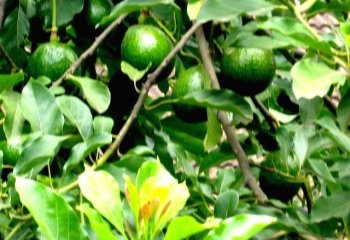
Post-harvest practices.
After harvesting, avocado fruit must be transferred carefully from the picking bag to field crates to avoid mechanical injuries, particularly bruising. It is important to prevent any contact with the ground to avoid contamination by foodborne pathogens that can survive in the soil. The fruit is typically packaged in large wooden crates, which hold around 11 kg of fruit. These containers should not be overfilled and must be placed in a shaded area to protect them from direct sunlight. Exposure to the sun increases the pulp temperature, accelerating ripening and shortening the shelf life of the fruit. Once the fruit arrives at the packing house, it undergoes sorting and grading based on criteria such as size, skin color, and physiological condition. This ensures consistency and quality of the final product.
Value addition and markets
Avocado, often hailed as a superfood, has experienced a remarkable surge in popularity and market value in recent years. Mexico leads avocado production, with global demand rising in the US, Europe, and Asia. Avocado's eco-friendly image adds to its market presence. Avocados are becoming increasingly popular in Africa, both for domestic consumption and export. The top five avocado-producing countries in Africa are Kenya, Rwanda, South Africa, Cameroon and DRC Congo. According to Trade statistics from International Trade Centre (ITC), Kenya became the 8th largest Avocado exporter in the world in 2017, exporting a record volume of 51, 507 tons to the world. There is significant potential for value-added products, such as avocado oil, butter, guacamole and skin products (Statista, n.d, Soko directory, n.d)
Fresh Quality Specifications for the market in Kenya
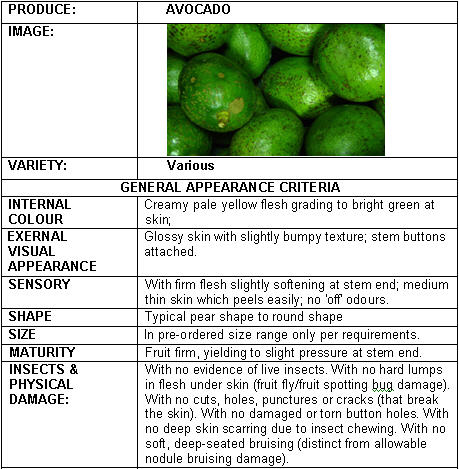 |
|
Ⓒ S. Kahumbu, Kenya |
Nutritional value
Avocado is a nutrient-dense fruit that is well-known for its health benefits. The fruit is rich in healthy fats which mainly consist of monounsaturated and polyunsaturated fats which can help reduce cholesterol levels, lower inflammation and improve heart health. Avocado is a good source of minerals particularly potassium, essential for regulating blood pressure and fluid balance in the body. It also contains magnesium which plays a vital role in bone health, muscle function, and energy production. Furthermore, avocado provides a moderate amount of calcium which is crucial for bone and teeth health.
The fruit is a powerhouse of bioactive compounds that offer several health advantages. Avocado is a rich source of dietary fiber, which aids digestion, supports gut health, and promotes satiety. Additionally, it is loaded with vitamins, including vitamin K, vitamin B6, vitamin C, vitamin E, and folate, and also contains small amounts of thiamin, riboflavin, niacin, and vitamin B12. The vitamin K in avocado supports bone health by increasing calcium absorption and reducing the urinary excretion of calcium as this may prevent osteoporosis. The folate content in avocados supports fetal health during pregnancy by reducing the risk of miscarriage and neural tube abnormalities. The abundance of antioxidants in avocados, such as beta-carotene can help protect against oxidative damage, inflammation, and chronic diseases (Ingram et al., 201, Hurtado et al., 2018, Hyson, P. (2023).
Table 1: Proximate nutritional content of 100 g of avocado (Persea americana) ripe raw fruit.
|
Food Name |
Avocado, ripe, raw |
Recommended daily allowance (approx.) for adultsa |
|
Proximate composition and dietary energy |
|
|
|
Edible conversion factor |
0.71 |
|
|
Energy (kJ) |
761 |
9623 |
|
Energy (kcal) |
185 |
2300 |
|
Water (g) |
74 |
2000-3000c |
|
Protein (g) |
1.6 |
50 |
|
Fat (g) |
19.6 |
<30 (male), <20 (female)b |
|
Carbohydrate available (g) |
0 |
225 -325g |
|
Fibre (g) |
4 |
30d |
|
Ash (g) |
1.9 |
|
|
Mineral composition |
|
|
|
Ca (mg) |
19 |
800 |
|
Fe (mg) |
1 |
14 |
|
Mg (mg) |
25 |
300 |
|
P (mg) |
41 |
800 |
|
K (mg) |
281 |
4,700f |
|
Na (mg) |
7 |
<2300e |
|
Zn (mg) |
0.39 |
15 |
|
Se (mcg) |
0 |
60 |
|
Cu (mg) |
0.30h |
0.9 |
|
Bioactive compound composition |
|
|
|
Vit A RAE (mcg) |
2 |
800 |
|
Vit A RE (mcg) |
5 |
800 |
|
Retinol (mcg) |
0 |
1000 |
|
b-carotene equivalent (mcg) |
27 |
600 – 1500g |
|
VIT D (mcg) |
0h |
5 – 15* |
|
VIT E (mg) |
0.6h |
9 |
|
Thiamin (mg) |
0.07 |
1.4 |
|
Riboflavin (mg) |
0.15 |
1.6 |
|
Niacin (mg) |
1.8 |
18 |
|
VIT B6(mg) |
0.22h |
1.3 |
|
Folate (mcg) |
67 |
400f |
|
Vit B12 (mg) |
0 |
3 |
|
Vit C (mg) |
14 |
60 |
Source (Nutrient data): FAO/Government of Kenya. 2018. Kenya Food Composition Tables. Nairobi, 254 pp. http://www.fao.org/3/I9120EN/i9120en.pdf
$ Draining the water several times leaches away water soluble nutrients significantly.
a Lewis, J. 2019. Codex nutrient reference values. Rome. FAO and WHO
b NHS (refers to saturated fat)
c https://www.hsph.harvard.edu/nutritionsource/water/
d British Heart Foundation
e FDA
f NIH
g Mayo Clinic
hWest African food composition table, https://www.fao.org/3/ca7779b/CA7779B.PDF
Recipes
Avocado is a versatile and nutritious fruit that can be used in a variety of recipes, from salads, Sandwiches and smoothies.
Avocado Smoothie
Ingredients:
• 1 ripe avocado, pitted and sliced
• 1 banana
• 1 cup spinach or kale
• 1 cup almond milk (or your choice of milk)
• 1 tablespoon honey or maple syrup (optional)
• Ice cubes (optional)
Preparation instructions
• Blend all the ingredients until smooth.
• Add more milk if needed for desired consistency.
Ref: Barber, 2023
Guacamole
Guacamole is a Mexican dip/spread made from mashed avocados, lime juice, salt, and cilantro, often with tomatoes and onions.
• 2 ripe avocados
• 1 small onion, minced
• 2 cloves garlic, minced
• 1 ripe tomato, diced
• 1 lime, juiced
• Salt and pepper to taste
• Fresh cilantro, chopped (optional)
Preparation instructions
• Cut the avocados in half, remove the pit, and scoop the flesh into a bowl.
• Mash the avocados with a fork.
• Stir in the minced onion, garlic, diced tomato, lime juice, salt, and pepper.
• Add chopped cilantro for extra flavour if desired.
Ref: Maryellen., 2023
Avocado Toast
Ingredients:
• 2 slices of whole-grain bread
• 1 ripe avocado
• Salt and pepper to taste
• Optional toppings: poached egg, sliced tomatoes, red pepper flakes, or feta cheese
Preparation instructions
• Toast the bread to desired level of crispiness.
• While the bread is toasting, slice the avocado and remove the pit.
• Mash the avocado onto the toasted bread.
• Season with salt and pepper.
• Add your favourite toppingsComments: A quick and healthy breakfast or snack option.
Information on Pests
Insect pests are not serious constraints to avocado production at present.
The most common insect pests attacking avocados are:
| False codling moth (Cryptophlebia leucotreta) The false codling moth is small (wingspan of 16 - 20 mm), dark brown to grey in colour. The moths are active at night. Female moths lay single eggs mostly on the fruit. After emerging from the egg, the young caterpillar tunnels into the fruit and the fruit sap thus liberated forms a typical white crystalline excrescence on the surface of the fruit. When moths lay eggs on young fruits the caterpillars usually die and thus large caterpillars are seldom found. However, the caterpillars are able to develop if fruits are approaching maturity when infested. The young caterpillar is creamy-white with a dark brownish head. With age the body turns pinkish red. The fully-grown caterpillar is 15 to 20 mm in length. When mature the caterpillar leaves the fruit and pupates in the soil or beneath surface debris. What to do:
|
| Avocados, especially thin-skinned varieties might be attacked by various species of fruit flies. Some fruit flies lay eggs under the skin of the fruit that is just beginning to ripen, but others attack young and old fruit. When the fruit reaches about the size of a golf ball a sting lesion appears as a slight puncture mark surrounded by a white exudate. As the fruit develops the lesion becomes dry and turn into distinct star-shaped crack on the skin surface. What to do:
|
| Scales are small, stationary brown greenish insects occasionally found sucking sap from avocado leaves. Soft scales such as Coccus spp. excrete large amount of honeydew, which lead to the development of sooty mould on leaves, branches and fruit. Honeydew attracts ants, which while feeding on the honeydew protect scales from natural enemies. Armoured scales such as the coconut scale (Aspidiotus destructor) may encrust young twigs, leaves and fruit. They do not produce honeydew. Scales are usually not a problem in avocado orchards; however, damage can be serious on young tress and small twigs may be killed. Although the presence of scales on the skin of fruit does not cause internal damage, it may lead to rejection of fruit, especially if grown for export. What to do:
|
| Thrips are small, slender insects (1-2 mm long) with two pairs of fringed wings. Adult thrips attacking avocado are dark brown or black, and the immature stages are yellow in colour. The red-banded thrips can be distinguished by a bright red band across the abdomen of immature thrips. Thrips are sometimes troublesome pests in avocado. They may cause damage to the leaves and fruit. Affected parts become whitish or silvery and are usually covered by dark-coloured droppings. On fruit, feeding begins near the calyx, gradually producing a scar that can cover the whole fruit. Attacked fruits develop a leathery brown skin. Feeding is most common on young fruit; economic damage generally occurs on fruit up to 2 cm in length (2-3 weeks after fruit set). Older fruit with thicker skin is less susceptible to attack. What to do:
|
| Bugs (Coconut bugs, Helopeltis bugs, stink bugs) Adult coconut bugs (Pseudotheraptus wayi) are brown in colour and 10 to 15 mm long. Nymphs are red brown to green brown in colour and have long antenna. The adults and nymphs of the coconut bug feed on young and mature avocado fruit. Bug feeding causes necrotic bruise-like depressions. A hard lump develops, which can be easily removed when the fruit is peeled. Helopeltis bugs also known as tea mosquito or mired bug are slender, delicate bugs, about 7- 10 mm long and have long legs and antenna. The females are red and the males are brown to yellowish red. The bugs prefer to feed on young plant tissue piercing the shoots, stems, leaves peduncles, petioles and fruits. Their feeding causes brown necrotic patches. Attacked leaves present angular lesion, which often drop out leaving holes as it attacked by biting insects. Feeding on young shoots causes dieback of the shoots. Feeding on fruits causes first a dark water-soaked mark around the feeding puncture, turning into a lesion with a light brown centre and black edge. The fruit may exude sap that forms a whitish deposit as it dries. Stink bugs are shield-shaped bugs variable in size (6 to 15 mm long) and colour (green to brown or reddish brown). They emit a characteristic unpleasant odour when disturbed. They usually feed on the developing fruit. The feeding punctures cause local necrosis resulting in fruit spotting, and deformation. What to do:
|
| Spider mites (Oligonychus spp.) Attack by spider mites (Oligonychus spp.) produce circular necrotic spots covered by dense webbing. As mite populations increase feeding causes leaf drop. These mites are more damaging to 'Haas' variety; 'Fuerte' variety is less affected. Feeding by broad mites (Polyphagotarsonemus latus) causes leaf distortion. These tiny mites (0.1-0.2 mm long) cannot be seen with the naked eye, and are even difficult to detect with a hand lens. An attack by the broad mites can be detected by the symptoms of damage. Their feeding produces discolouration, necrosis and deformation of tissues. What to do:
|
Information on Diseases
| The fungus readily infects young, succulent tissues of leaves, twigs and fruits. Lesions appear as small dark spots, slightly raised, oval to elongated. These spots join up, giving a corky appearance to the surface of the fruits, impairing the appearance but not the internal quality of the fruit. Fruits are only susceptible when young until about half size development. The fungus requires moist conditions for sporulation and infection. What to do:
|
| Avocado root rot (Phytophthora cinnamomi) This disease can attack trees of any size and age. Leaves of infected trees are small, usually pale or yellow green, are often wilted and fall prematurely giving the tree sparse appearance. In advanced stages of the disease, branches die-back and fruit remains small and crop yield drastically reduced. Feeder roots get blackened, decayed and died. Infected trees die prematurely. The disease is prone in areas subject to flooding and in poorly drained soils. The fungus can be spread or introduced to new areas by use of infected seeds, infested soil, irrigation water containing spores of the fungus and infected seedlings. The host range of the fungus includes Acacia, Camellia, Casuarina, Cypress, Eucalyptus and Grevillea. What to do:
|
| Anthracnose (Colletotrichum gloeosporioides) This fungal disease is primarily a post-harvest problem when fruit is at maturity stage. Infection takes place when fruit is still very young and the fungus stays dormant till the fruit ripens. The disease appears as depressed spots on the fruit and the spots are manifested as a rot, which can penetrate deep into the flesh. In wet weather, the spots may be covered with mass of slimy, salmon pink fungal spore mass. The disease may develop very rapidly in storage if conditions in storage are humid and warm. The anthracnose fungus lives saprophytically on twigs, rotten fallen fruits and dead or dying infected leaves. The fungus is spread by water splash. What to do:
|
| Cercospora fruit spot (Pseudocercospora purpurea) The disease is primarily a problem to quality of fruits. The severity of infection varies from season to season and can cause losses of up to 60%. The lesions appear as small light-yellow spots on fruits and leaves. They later become reddish brown and eventually become hard and crack. Mature fruits are resistant. The disease development is favoured by humid conditions and high temperatures. The fungus is essentially spread by water splash and its spores are also wind-borne. What to do:
|
Contact Information
KENYA
• www.kalimonigreens.com Corner Shop Nairobi:cornershop@africaonline.co.ke, +254 (0) 0716 905 486, (20) 2712268/9
• Green Dreams: info@organic.co.ke +254 (0) 724 781 971/ 0722 562 717001
• Kalimoni Greens: www.kalimonigreens.com , +254 (0) 708 278 273
• Karen Provision Stores:kps@nbi.ispkenya.com +254 20 882 252, 0736 371 437
• Muthaiga Green Grocers, Nairobi
• Horticultural Research Institute, Thika: director.hri@kalro.org. +254 (20) 2055038
• Zuchinni Green Grocers, Nairobi. +254 (20) 2215067
• East Africa Fruits Co. Ltd. (Tanzania):They specialize in Hass, Fuerte, and other popular avocado varieties. web page, https://www.eafruits.com. Address: Bunju B, Kilimani Road, Dar es Salaam, Tanzania, Phone Number: +255-672-227-777, Email: info@eafruits.com
• Seed Co Limited: They have operations in several African countries, including Zambia, Malawi, and Tanzania.
ZIMBABWE- Seed Co Zimbabwe ; Telephone: +263 242 308881/8, 308127 ; Switchboard Cell: +263 8677020255 ; Email: seedco@seedcogroup.com .
KENYA- Seed Co Limited Physical Location: Mombasa Road (Next to Mabati Rolling Mills), P. O. Box 616-00621 Nairobi Mail: seeds@seedcogroup.com
TANZANIA
• Seed Co Tanzania Limited. Ngaramtoni ya Chini, First Floor, Sable Square P.O Box 12281. Arusha Tanzania Office: +255 739 210 909
• Africado (Tanzania): Operates in: Tanzania and Kenya. They specialize in Hass and Fuerte varieties and also offer training and support to farmers. Web page. https://www.norfund.no/investment/africado-ltd/
MALAWI- Address: Lilongwe, Malawi, Postal Address: Private Bag 421, Kanengo,Lilongwe,Malawi, Contact Details, Phone: +265 71 2074, +265 71 2062, Fax: +265 71 2312, Cell: +265 999 971 143, Email: seedco@seedcomalawi.net
SOUTH AFRICA
Westfalia Fruit:Varieties, including Hass, Fuerte, and Pinkerton, and sell avocado seeds for planting to Iifarmers and individuals across Africa.Contact details: Westfalia Marketing Africa: +27 15 307 5253, Westfalia Fruit Products: +27 87 700 4436, Westfalia Technological Services: +27 15 309 0029, Westfalia Fruit Estates: +27 15 309 0000. Web. https://www.westfaliafruit.com/
References and information links
References
1. Bekele-Tesemma A, Birnie A, Tengnas B. 1993. Useful trees and shrubs for Ethiopia. Regional Soil Conservation Unit
2. CAB International (2005). Crop Protection Compendium, 2005 edition. Wallingford, UK www.cabi.org
3. De Villiers, E. A. (1990). Avocado Pest in South Africa. In Framing in South Africa. Avocado. Institute for Tropical and Subtropical Crops. Published by ARC.
4. Griesbach, J (2005). Avocado Growing in Kenya. World Agroforestry Centre, Nairobi, Kenya. ISBN: 92 9059 173 0. www.worldagroforestrycentre.org
5. Griesbach, J. (1992). A Guide to Propagation and Cultivation of Fruit Trees in Kenya. Schriftenreihe No. 230, Eschborn / Germany: GTZ. ISBN: 3-88085-482-3
6. HCDA. (1996). Avocados. Export Crop Bulletin: No 2 June 1996.
7. ICIPE (2006). A Field Guide to the Management of Economically Important Tephritid Fruit Flies in Africa. The International Centre of Insect Physiology and Ecology. ISBN: 92-9064-179-7.
8. KENYAWEB HORTICULTURE. Fruits- Avocado.
9. Mugambi, D.M. (2001). Market Status of Avocado and Associated Products in Kenya. RELMA Working Paper No. 12. RELMA, Nairobi, Kenya.
10. Muigai, J.K. and Mwaura, F.M. (2005). Preparation and Use of Avocado Oil and Its Products. Chapter 16 in Organic Resource Management in Kenya Perspectives and Guidelines. 2005. Forum for Organic Resource Management and Agricultural Technologies (FORMAT).
11. National Horticultural Research Station, Thika (1984). Horticultural Crops Protection Handbook. Ministry of Agriculture & Livestock Development, Kenya.
12. Nutrition Data www.nutritiondata.com.
13. Orwa C, A Mutua, Kindt R , Jamnadass R, S Anthony. 2009 Agroforestree Database:a tree reference and selection guide version 4.0 (http://www.worldagroforestry.org/sites/treedbs/treedatabases.asp)
14. Persea americana Mill. in GBIF Secretariat (2021). GBIF Backbone Taxonomy. Checklist dataset https://doi.org/10.15468/39omei accessed via GBIF.org on 2021-12-18.
15. PIP Pesticides Initiative Programme (PIP) with collaboration of NRI. Crop production protocol Avocado (2011). www.coleacp.org/pip
16. Protrade. Avocados. Export Manual Tropical Fruits and Vegetables.
17. Specialty produce. Hass Avocado. https://www.specialtyproduce.com/produce/Hass_Avocado_12139.php
18. Specialty produce. Fuerte Avocados https://www.specialtyproduce.com/produce/Fuerte_Avocados_6723.php
19. Tree Crop Propagation and Management (2000). A farmer Trainer Training Manual. Integration of Tree Crops into Farming Systems Project- GTZ, Ministry of Agriculture and Rural Development) MoARD.
20. Flores, M., Saravia, C., Vergara, C. E., Avila, F., Valdés, H., & Ortiz-Viedma, J. (2019). Avocado oil: Characteristics, properties, and applications. Molecules, 24(11), 2172.
21. Freshela Exporters. (n.d.). Uganda Avocado Varieties. Retrieved May 12, 2023, from https://www.freshelaexporters.com/avocado/varieties/uganda
22. Kew Science. (n.d.). Persea americana Mill.. Plants of the World Online. Retrieved May 12, 2023, from https://powo.science.kew.org/taxon/urn:lsid:ipni.org:names:325643-2
23. Ingram, D. K., Elks, C. M., Davenport, G. M., & Roth, G. S. (2013). Potential health benefits of avocados. Bioactives in Fruit: Health Benefits and Functional Foods, 337-352.https://onlinelibrary.wiley.com/doi/abs/10.1002/9781118635551.ch14
24. Hurtado-Fernández, E., Fernández-Gutiérrez, A., & Carrasco-Pancorbo, A. (2018). Avocado fruit—Persea americana. In Exotic fruits (pp. 37-48). Academic Press.https://www.sciencedirect.com/science/article/abs/pii/B9780128031384000010
25. Hyson, P. (2023). How Many Calories in an Avocado? Avocado Calories and Nutrition. ORDER, 1, 00.https://www.miamiherald.com/health-wellness/article271910122.html
26. Yahia, E. M., & Woolf, A. B. (2011). Avocado (Persea americana Mill.). In Postharvest biology and technology of tropical and subtropical fruits (pp. 125-186e). Woodhead Publishing.
27. Barber, C. (2023, September 6). Avocado & Banana Smoothie. EatingWell. https://www.eatingwell.com/recipe/7899506/avocado-banana-smoothie/
28. Maryellen. (2023, August 14). Guacamole. Allrecipes. https://www.allrecipes.com/recipe/14231/guacamole/
Information Source Links
- CAB International (2005). Crop Protection Compendium, 2005 edition. Wallingford, UK www.cabi.org
- De Villiers, E. A. (1990). Avocado Pest in South Africa. In Framing in South Africa. Avocado. Institute for Tropical and Subtropical Crops. Published by ARC.
- Griesbach, J (2005). Avocado Growing in Kenya. World Agroforestry Centre, Nairobi, Kenya. ISBN: 92 9059 173 0. www.worldagroforestrycentre.org
- Griesbach, J. (1992). A Guide to Propagation and Cultivation of Fruit Trees in Kenya. Schriftenreihe No. 230, Eschborn / Germany: GTZ. ISBN: 3-88085-482-3
- HCDA. (1996). Avocados. Export Crop Bulletin: No 2 June 1996.
- ICIPE (2006). A Field Guide to the Management of Economically Important Tephritid Fruit Flies in Africa. The International Centre of Insect Physiology and Ecology. ISBN: 92-9064-179-7.
- KENYAWEB HORTICULTURE. Fruits- Avocado.
- Mugambi, D.M. (2001). Market Status of Avocado and Associated Products in Kenya. RELMA Working Paper No. 12. RELMA, Nairobi, Kenya.
- Muigai, J.K. and Mwaura, F.M. (2005). Preparation and Use of Avocado Oil and Its Products. Chapter 16 in Organic Resource Management in Kenya Perspectives and Guidelines. 2005. Forum for Organic Resource Management and Agricultural Technologies (FORMAT).
- National Horticultural Research Station, Thika (1984). Horticultural Crops Protection Handbook. Ministry of Agriculture & Livestock Development, Kenya.
- Nutrition Data www.nutritiondata.com.
- PIP Pesticides Initiative Programme (PIP) with collaboration of NRI. Crop production protocol Avocado (2011). www.coleacp.org/pip
- Protrade. Avocados. Export Manual Tropical Fruits and Vegetables.
- Tree Crop Propagation and Management (2000). A farmer Trainer Training Manual. Integration of Tree Crops into Farming Systems Project- GTZ, Ministry of Agriculture and Rural Development) MoARD.
- https://wikifarmer.com/all-avocado-varieties-explained-characteristics-and-advantages/
- https://www.kalro.org/csapp/images/AVOCADO-VARIETIES-edited-25-May-2017.pdf
- https://www.medicalnewstoday.com/articles/270406#benefits (Accessed on 17th may 2023)
- https://www.statista.com/statistics/931183/global-avocado-market-value/#:~:text=This%20statistic%20shows%20the%20market,billion%20U.S.%20dollars%20by%202026.
- https://sokodirectory.com/2019/01/kenya-leads-as-the-biggest-avocado-producer-in-africa/
- https://www.persistencemarketresearch.com/market-research/avocado-market.asp
Review Process
Dr. Patrick Maundu, James Kioko, Charei Munene and Monique Hunziker, March 2024

